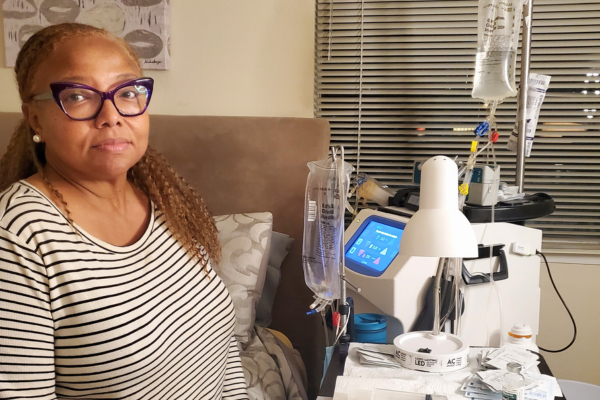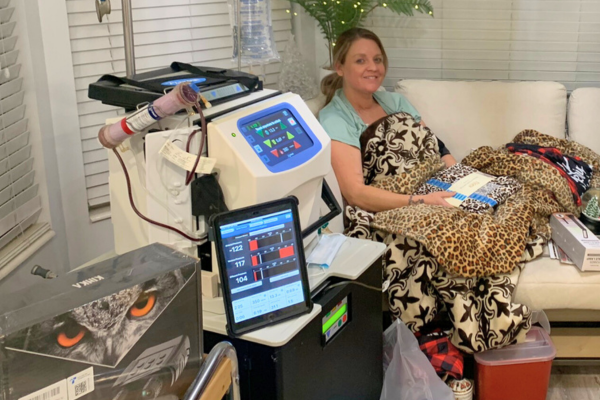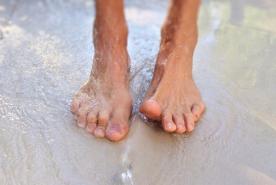January 21, 2025
Today, those with kidney failure have multiple treatment options. Most know about in-center dialysis and kidney transplantation. Many aren't aware of treatments like home hemodialysis.
What is home hemodialysis, and who could benefit from it? Bell Maddux, a home hemodialysis patient, and Jenny Wilson, the Regional Director of a home dialysis program in New York City, break it down.
What is Hemodialysis?
Hemodialysis is a treatment that cleans the blood when the kidneys can't. It can be performed in-center by dialysis workers or at home by the patient and care partner.
There are three types of home hemodialysis:
- Conventional: Three times a week for three or more hours each session.
- Short daily: Five to seven times a week with specialty machines for around two hours each session.
- Nocturnal (nighttime): Up to six nights a week or every other night for six to eight hours a session.
Doing dialysis at home gives people control over their schedule.
"More frequent treatments result in a gentler dialysis experience that usually reduces post-dialysis side effects. There is less cramping. People don't usually feel the post-dialysis "hangover," Jenny said. "There are also fewer fluctuations in blood pressure, which can make people feel tired, dizzy, and weak."
Other pros include not needing transportation to a dialysis center and a less restrictive diet.
"Cons include having a large number of supplies in the home. Many people need a care partner and training becomes a full-time job for several weeks,” Jenny said. "You may have to search for a new dialysis center since not all offer this modality"
Subscribe today!
Join the NKF Blog Newsletter
Get inspirational stories and kidney disease resources delivered to your inbox every month. You'll gain practical insights and expert advice to help you better understand and manage your kidney health no matter where you are on your kidney journey.
How to Start Home Hemodialysis
Bell learned about home dialysis when her husband's kidneys failed.
"My husband chose peritoneal dialysis (PD), where the inside lining of the belly and a fluid called dialysate perform the functions of the kidney," Bell said. "I was diagnosed with kidney disease at 15. My dad donated a kidney to me in my twenties. Nine years later, the transplant started failing."
Bell paid attention to her husband's treatment and lifestyle. She decided PD wasn't for her and chose in-center hemodialysis when her transplant failed.
"The dialysis staff would ask why I wasn't pursuing home hemodialysis," said Bell. "I was young, had small children, and the ability to do it. They pushed me to discuss it more with my kidney doctor."
Bell learned how home hemodialysis worked. She asked about the benefits, challenges, and support she’d need.
"For home hemodialysis, you need vascular access. This is usually a fistula or access made by joining an artery and vein in the arm," Jenny said. "Most people also need a care partner, but solo home hemodialysis is an option for those with the ability to perform it."
While home hemodialysis is safe and has fewer side effects, it does involve needles, blood, and managing equipment.
Care partners can help in different ways:
- Emergency Support: Some care partners are only there for issues.
- Hands-On Help: Other caregivers have more active roles and may set up the machine or insert needles (cannulation).
"My husband had his dialysis and long work schedule. I decided to do solo home hemodialysis," Bell said. "I learned how to become my own nurse and technician."
It took time for Bell to train and become that confident.
"Training is extensive, around 5 weeks for four days each week. Topics range from infection control, how to cannulate, and troubleshooting,” Jenny said. “Patients learn what to do during emergencies, how to document treatments, do blood work, and administer medications."
The last days of training occur in the home. Patients perform their treatments with a healthcare provider watching and helping if necessary.
"This treatment gives me the autonomy and control that I lost when my kidneys failed. It's been great for my mental health," Bell said. "It isn't all great though. I was very well trained but have made mistakes. Repetition and time built my confidence and skills."
Have questions about home hemodialysis? Contact NKF Cares toll-free at 855.653.2273 or email nkfcares@kidney.org to ask questions and get answers from trained professionals.
Home Hemodialysis Myths Busted
Some people believe myths about home hemodialysis that make them nervous about trying it.
"There are a lot of myths to bust," Jenny said. "I haven't met any patients with an overall negative experience of home hemodialysis in my 12 years in the field. There are questions. Things go wrong but patients are trained to manage all of that."
Here are the top three myths and the truth behind them:
Myth 1: I Can't Do It
While home hemodialysis may feel intimidating, you are more capable than you may believe.
"The biggest myth is thinking you can't do it. You may think, 'I'm not a healthcare professional. I am not equipped to do this without it being dangerous,'" Bell said. "Mistakes will happen. They are the best way to learn. Each one I handled proved I could do it."
Connect with others who have home hemodialysis experience. Join NKF's anonymous kidney dialysis community.
Myth 2: You Can't Have Pets
Many people believe that you can't have pets and do home hemodialysis. This is false.
"Of course, you can have pets," Jenny said. "We suggest that you take some precautions to keep everything sanitary."
Here are a few tips:
- Pet-Free Zone: Keep pets separate from the space where you do dialysis and store your supplies.
- Clean Regularly: Wipe surfaces down, vacuum, and dust often to minimize allergens and keep the environment clean.
- Wash Your Hands: Always wash your hands after handling pets and before touching dialysis supplies.
Learn more about infections and hemodialysis.
Myth 3: Home Hemodialysis Limits Physical Activities
There are actually few physical limitations for home hemodialysis patients.
"Due to the nature of vascular access, there are precautions. One is to avoid lifting, pulling, or pushing heavy weights," Jenny said. "Weight limit will be determined based on your activity level or before starting dialysis. Ask your doctor–there is no one-size-fits-all recommendation."
Activities encouraged include:
- Running
- Walking
- Tai chi
- Swimming with proper infection control precautions
- Cycling
Next Steps
Ready to learn more about home hemodialysis? Talk to your doctor or dialysis staff about the next steps. They will educate and guide you on this journey.
"Take time to understand the benefits and challenges," said Bell. "Gather all the information to see how it will affect your life personally and then make a choice."
Ask your Representative to help more patients access home dialysis.
*This content is provided for informational use only and is not intended as medical advice or as a substitute for the medical advice of a healthcare professional.










